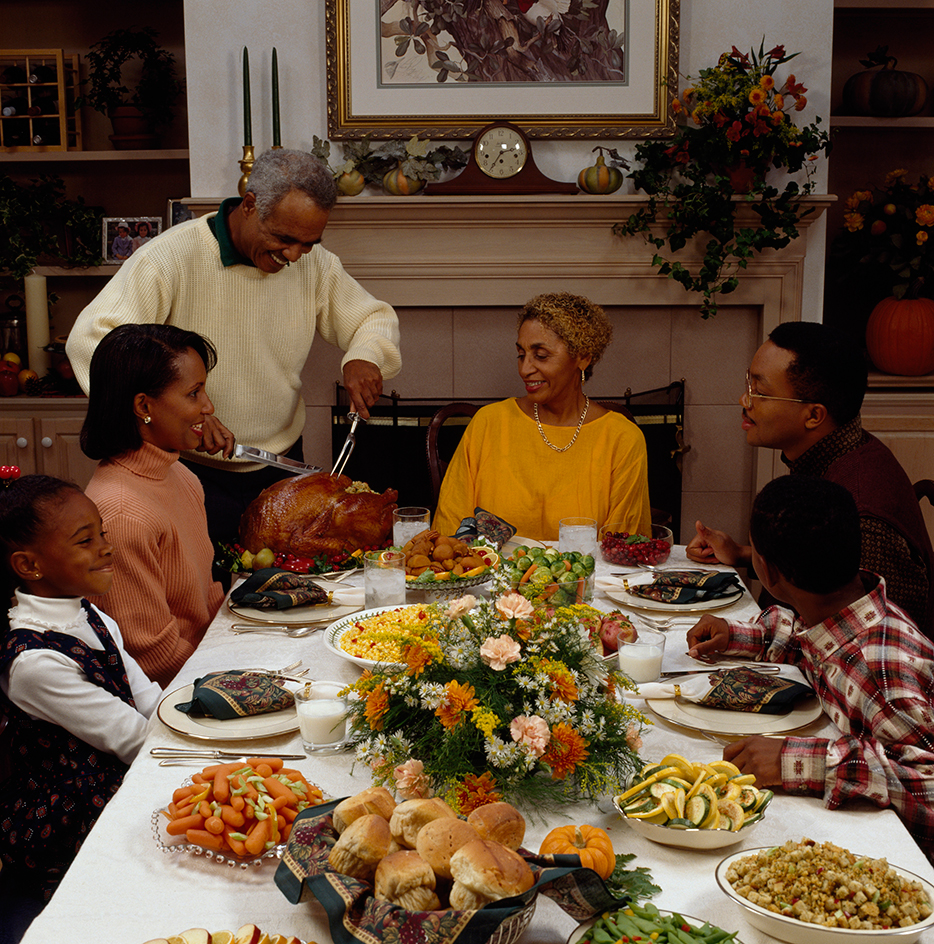Thanksgiving Day is a day set aside each year in the United States and Canada for giving thanks and remembering the blessings of life. People may celebrate the day with family gatherings, feasting, and prayer. For many people, Thanksgiving calls forth memories of tables crowded with food, happy reunions, football games, and religious contemplation.

For thousands of years, people in many parts of the world have held harvest festivals. The American Thanksgiving Day grew out of these harvest home celebrations. For this reason, the holiday takes place late in the fall, after the crops have been gathered.
Many Native American groups have a long tradition of celebrations of thanks for the bounties of the earth. European peoples have also held autumn harvest festivals and feasts for centuries. In 1619, a group of 38 English settlers arrived at Berkeley Plantation, near what is now Charles City, Virginia, on December 4. The group’s charter required that the day of arrival be observed yearly as a day of thanksgiving to God.
More than any other American holiday, Thanksgiving Day is surrounded with tradition, myth, and legend. Popular accounts of the first thanksgiving at Plymouth Colony, held by Native Americans and English pilgrims in 1621, do not stand up to the historical facts known about the gathering. Furthermore, for many modern Native Americans, also called Indigenous Americans, the holiday serves as a sad reminder that the arrival of Europeans ultimately had many tragic consequences for them. Many Native Americans do not celebrate the arrival of Europeans in the Americas, and some mark the day differently. For example, some Native Americans observe a National Day of Mourning in Plymouth, Massachusetts.
However, one legacy of thanksgiving that has endured and remains true to the historical record is the theme of generosity. For three days in the autumn of 1621, some Native American inhabitants of New England joined English colonists in sharing the gifts of the land with one another. Each November, many Americans continue this tradition with family and friends.
Plymouth Colony.
The Plymouth Colony was founded by English pilgrims in 1620 at the site of a deserted Wampanoag village called Patuxet. The colonists’ first winter in Plymouth was harsh, and about half of them died. In the spring of 1621, however, a Patuxet man named Tisquantum—called Squanto by the English—showed them how to plant traditional Native American crops of corn and pumpkin in addition to their European peas, wheat, and barley. In early autumn of 1621, the governor of Plymouth, William Bradford, organized a festival to give thanks to God for the survival of the colony and for their first harvest.
The festival lasted three days. Tradition holds that the colonists invited Massasoit, the Wampanoag chief, although some versions of the story claim he came to negotiate a new land treaty. He arrived with about 90 of his people and contributed five deer to the feast. The women of the settlement supervised cooking over outdoor fires. Foods served probably included duck and turkey; a corn porridge called nasaump; and a pumpkin dish called pompion. The English and the Wampanoag played games and engaged in contests of skill, and the English held a military review. The colonists held similar harvest celebrations for several years. The Wampanoag did not always participate. Good relations between the colonists and the Native Americans eventually ended because of disputes over land, religious beliefs, and cultural traditions.
Later thanksgiving days in the United States.
The custom of thanksgiving days spread from Plymouth to other New England colonies. During the American Revolution (1775-1783), the Americans observed eight special days of thanks for victories and for being saved from dangers. In 1789, President George Washington issued a general proclamation naming November 26 a national day of thanksgiving.
For many years, the country had no regular national Thanksgiving Day. But some states had a yearly thanksgiving holiday. By 1830, New York had an official state Thanksgiving Day, and other Northern states soon followed its example. In 1855, Virginia became the nation’s first Southern state to adopt the custom.
Sarah Hale, the editor of Godey’s Lady’s Book, worked many years to promote the idea of a national Thanksgiving Day (see Hale, Sarah Josepha). Then President Abraham Lincoln proclaimed the last Thursday in November 1863, as “a day of thanksgiving and praise to our beneficent Father.” Each year afterward, the president formally proclaimed that Thanksgiving Day should be celebrated on the last Thursday of November. But in 1939, President Franklin D. Roosevelt set it one week earlier to help business by lengthening the shopping period before Christmas. Congress ruled that after 1941 the fourth Thursday of November would be observed as Thanksgiving Day and would be a legal federal holiday.
Thanksgiving Day in Canada
is celebrated in much the same way as in the United States. The first Canadian thanksgiving was celebrated in Newfoundland in 1578. The English captain Martin Frobisher held a ceremony to give thanks for surviving the long sea journey from England. Thanksgiving Day in Canada was formerly celebrated on the last Monday in October. But in 1957, the Canadian government proclaimed the second Monday in October to be the holiday.
